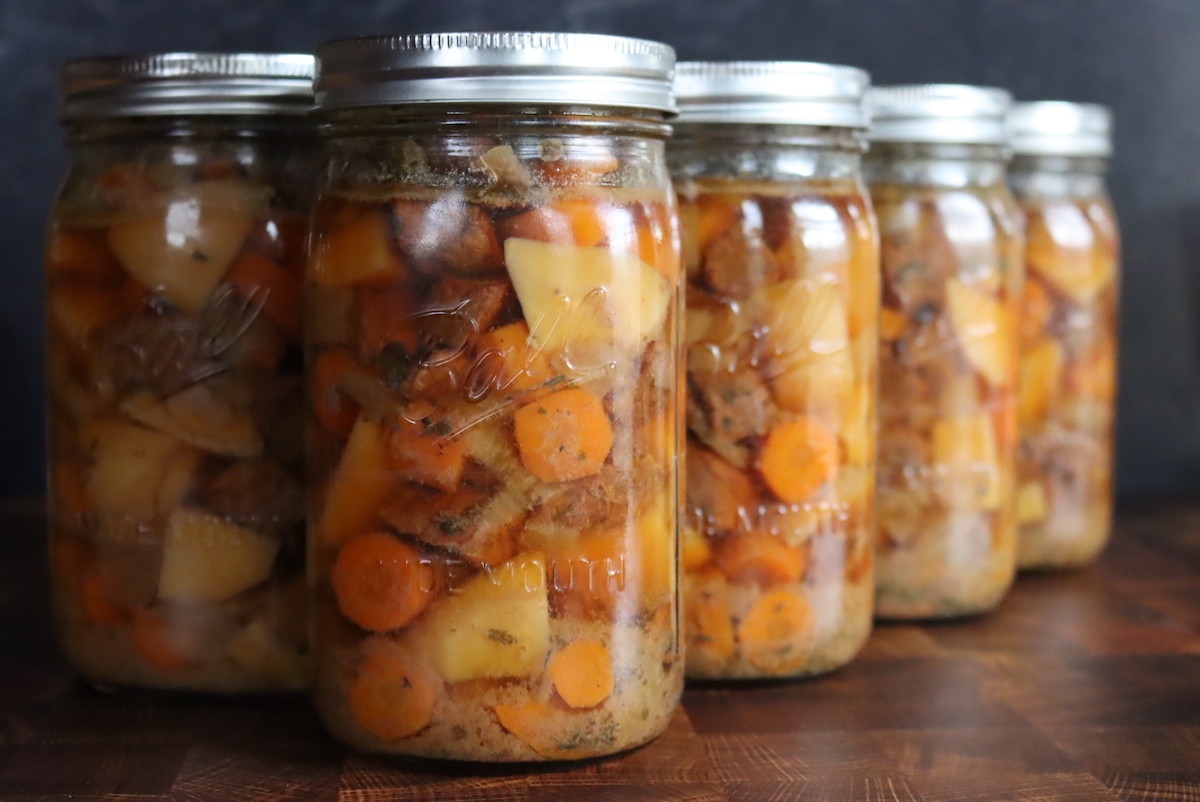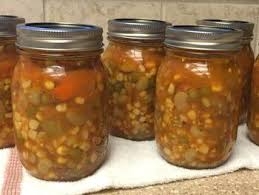Canning vegetable soup without pressure cooker?
Do you have an abundance of fresh vegetables in your garden and want to preserve them for the colder months? Canning is a great way to make your produce last longer, but many people are intimidated by the process of using a pressure cooker. Is it possible to can vegetable soup without one?
Pressure canning is the most common method for canning low-acid foods like vegetables, meats, and soups. However, not everyone has access to a pressure cooker or feels comfortable using one. Luckily, there are alternative methods for canning vegetable soup that are just as effective and safe.
If you want to enjoy your garden’s bounty all year round, canning vegetable soup is a great way to do so. But don’t let the lack of a pressure cooker hold you back. In this article, we’ll explore the steps and equipment you need to safely can vegetable soup without a pressure cooker. With a little bit of preparation and patience, you can have delicious, homemade soup all winter long.
What is Canning?
Canning is a food preservation technique that allows people to store food for long periods of time without the need for refrigeration. This is achieved by sealing the food in airtight containers, such as glass jars or metal cans, and then heating it to a high temperature. The heat kills any bacteria or microorganisms that may be present in the food, which prevents it from spoiling.

Canning is an excellent way to preserve excess produce from the garden or to save money by buying in bulk. It is also a great way to ensure that you always have healthy, nutritious food available, even during the off-season or in times of emergency.
There are two types of canning methods: water bath canning and pressure canning. Water bath canning is used for high-acid foods, such as fruits, jams, and pickles, while pressure canning is used for low-acid foods, such as meat, vegetables, and soups. It is important to use the correct canning method for the type of food being preserved to ensure safe processing.
Canning requires following precise instructions and protocols to ensure safety. Proper sterilization of equipment, using appropriate jars and lids, and following processing times and temperatures are all critical elements in producing safe, high-quality canned goods.
Canned foods are a staple in households all over the world. By canning food at home, you can enjoy flavorful, high-quality soup that is free of preservatives and chemicals. So, whether you are a novice or experienced home canner, consider giving canning a try and start enjoying the benefits of this classic preservation technique.
Why Can Vegetable Soup?
Vegetable soup is a delicious and healthy dish that can be enjoyed all year round. Not only is it a great way to incorporate a variety of vegetables into your diet, but it is also a convenient meal option for busy days. However, fresh produce has a shelf life, and sometimes it can be difficult to use up all of your vegetables before they spoil. This is where canning comes in.
Canning vegetable soup is a great way to preserve the fresh flavors and nutrients of vegetables for later use. By canning your own soup, you can have a quick and easy meal option on hand anytime, without having to worry about spoilage or waste. Moreover, canning your own vegetable soup allows you to control the ingredients, so you can adjust the recipe to suit your taste preferences or dietary restrictions.
Another advantage of canning vegetable soup is that it can save you money in the long run. Buying fresh vegetables in season or in bulk can be cost-effective, but if you can’t use them all before they spoil, you are essentially throwing away money. By canning your vegetables, you can make the most of your investment and enjoy the benefits of fresh vegetables all year round.
In addition, canning your own vegetable soup is a great way to reduce your dependence on store-bought canned foods. Many commercial canned soups contain high levels of sodium and preservatives, which can be detrimental to your health in the long term. By canning your own soup, you can be sure that you are consuming a healthier, more natural product that is free of harmful additives.
Finally, canning vegetable soup is a great way to prepare for emergencies or unexpected events. Having a stock of canned goods on hand can provide a sense of security and peace of mind, knowing that you are prepared for any situation.
Preparing the Soup
Before you start canning your own vegetable soup, you will need to prepare the soup itself. The good news is that canning soup without a pressure cooker is relatively easy, as long as you follow a few important steps.
The first step is to gather your ingredients. You can use fresh vegetables or frozen vegetables, depending on what you have available. It’s important to note that low-acid ingredients, such as green beans or cauliflower, require a pressure canner to ensure safe processing. However, if you are using mostly high-acid ingredients, such as tomatoes or onions, you can safely use a boiling water canner.
Next, it’s time to prepare the soup. Start by sautéing onions and any additional ingredients such as meat in a large pot. Once the onions are soft and the meat is cooked, add your vegetables of choice and enough water or broth to cover them. You can also add any seasonings you like, such as salt, pepper, garlic, or herbs.
Heat the soup to a simmer and let it cook until the vegetables are tender. Remove any excess fat or foam from the surface, then ladle the soup into clean, hot canning jars. Leave 1-inch of headspace at the top of each jar, then wipe the rim with a clean, damp cloth to ensure a good seal.
Finally, attach the metal lids to the jars and process them in a boiling water canner or a dial-gauge pressure canner, according to the instructions provided with your canner. The processing time will depend on the size of your jars and the type of canner you are using, so be sure to read the instructions carefully to ensure safe processing.
Canning Without a Pressure Cooker
Canning is an age-old practice that has been around for centuries. The process of canning involves preserving food in airtight containers to extend its shelf life. Traditional canning methods often required the use of a pressure cooker, which could be intimidating for beginners and those without access to one. However, with the right knowledge and equipment, it is possible to can vegetables and soups without a pressure cooker.
The key to canning without a pressure cooker is to use a water bath canner, also known as a boiling water canner. This is a large pot with a rack that holds canning jars off the bottom of the pot. The pot is then filled with water and heated to a rolling boil. The jars are then processed by submerging them in the boiling water for a set amount of time.
When canning without a pressure cooker, it is important to pay close attention to the acidity of the ingredients you are using. Low-acid ingredients, such as green beans and cauliflower, require a pressure canner to ensure safe processing. However, if you are using mostly high-acid ingredients, such as tomatoes or onions, you can safely use a water bath canner.
To can vegetable soup without a pressure cooker, start by preparing your ingredients. You can use either fresh or frozen vegetables, depending on what you have available. Begin by sautéing onions and any additional ingredients, such as meat, in a large pot. Once the onions are soft, add your choice of vegetables and enough water or broth to cover them. Add your preferred seasonings, such as salt, pepper, garlic, or herbs, to taste.
Heat the soup to a simmer and let it cook until the vegetables are tender. Remove any excess fat or foam from the surface. Ladle the soup into clean, hot canning jars, leaving an inch of headspace at the top of each jar. Wipe the rim of each jar with a clean, damp cloth to ensure a good seal. Attach the metal lids to the jars and process them in the boiling water canner for the recommended amount of time.
Supplies Needed for Canning Without a Pressure Cooker
When it comes to canning without a pressure cooker, there are a few key supplies that you will need in order to safely preserve your food. While the process may seem daunting at first, with the right tools and equipment, you can enjoy the benefits of home-canned soups and other foods.

Here are some of the essential supplies you will need for canning without a pressure cooker:
1. Water Bath Canner: As mentioned in our previous article, a water bath canner is a large pot with a rack that holds canning jars off the bottom of the pot. This allows for even heat distribution during the canning process. You can purchase a dedicated water bath canner, or use a large stockpot that is deep enough to fully submerge your jars.
2. Canning Jars: You will need glass jars specifically designed for canning. These can be found in various sizes, with the most common being pint and quart-sized jars. Make sure to choose jars that are in good condition, with no cracks or chips.
3. Canning Lids and Bands: Canning lids and bands are essential for creating a tight seal on your jars. Make sure to use new, unused lids every time you can, as the seal can weaken with repeated use.
4. Jar Lifter: A jar lifter is a specialized tool used to safely remove hot jars from the water bath canner. Using tongs or other tools can be dangerous, as they can easily slip and break the jars.
5. Funnel: A wide-mouthed funnel is helpful for filling your jars without spilling. Look for one with a good fit to your jars.
6. Clean Towels and Cloths: You’ll need plenty of clean towels and cloths for wiping down the jars, lids, and bands. Make sure to use materials that are clean and free of debris.
7. Kitchen Timer: Timing is important during the canning process, so make sure to have a reliable kitchen timer on hand.
By having these supplies on hand, you’ll be well-equipped to safely can soups and other foods without a pressure cooker. Remember to always follow the recommended processing time for your recipe, and pay attention to any safety issues or special instructions. With practice, you’ll soon be creating flavorful, high-quality soup that can be enjoyed for months to come.
Meet Jaxon Monroe, the culinary enthusiast and food blogger who has taken the online cooking world by storm with his passion for experimenting with flavors. With a sharp eye for detail and an innate ability to create and present dishes in an appealing way, Jaxon’s blog is the go-to for any food lover seeking inspiration.
From BBQ chicken pizza bites to healthy Thai spiced salmon cakes, Jaxon’s recipes draw upon a range of cuisines and flavors, each as tantalizing as the last. But it’s not just about indulgence – Jaxon also shares tips and tricks to help readers improve their cooking skills.
Whether you’re an experienced cook or just starting out, Jaxon’s blog offers valuable insights and creative ideas that will leave you inspired in the kitchen. So why not join the thousands of readers who have already discovered the magic of Jaxon Monroe’s unique take on cooking?